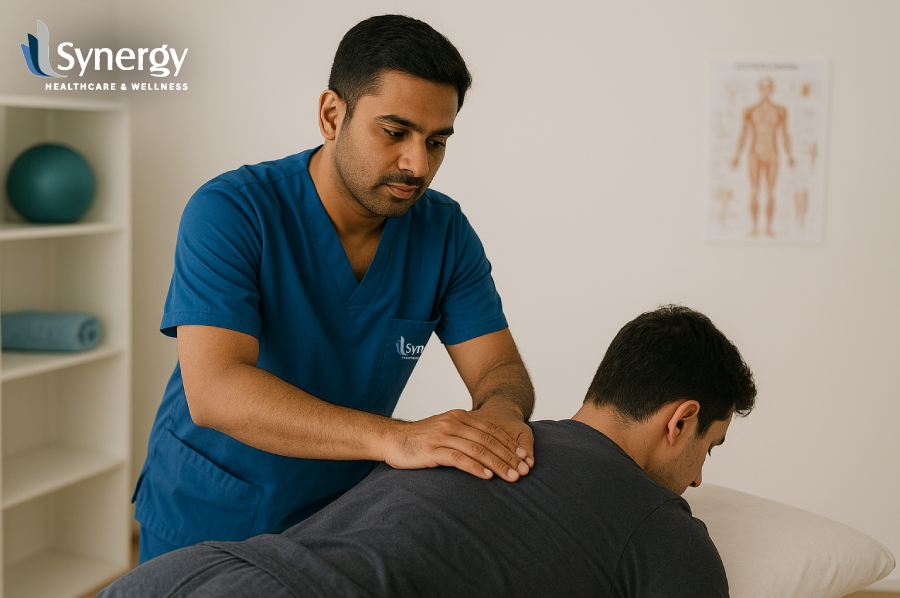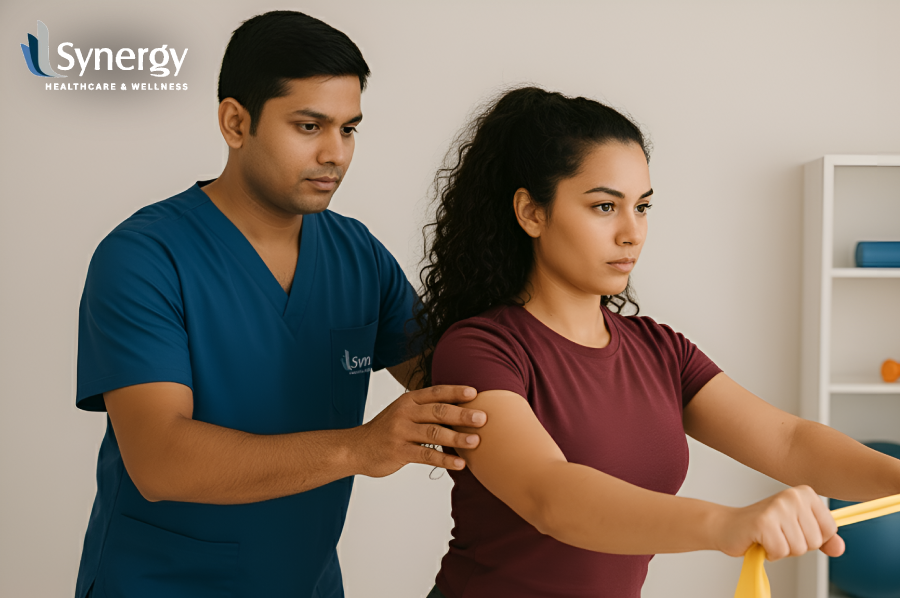Physiotherapy before and after surgery builds strength, restores motion, and prevents complications. Structured exercises and early movement help patients recover faster and return to daily life safely. With proper guidance and consistent effort, physiotherapy transforms surgical recovery into lasting well-being.
Let’s Begin
Physiotherapy after surgery helps the body regain movement, strength, and confidence. Before surgery, it can prepare muscles and joints for what lies ahead. After surgery, it accelerates recovery, reduces stiffness, and alleviates pain. A structured plan guided by a qualified physiotherapist allows smoother healing and a safer return to normal activity. This blog explains how physiotherapy, both for post-surgery recovery and pre-surgery preparation, works together to help patients heal efficiently and avoid long-term complications.
Pre-Surgery Preparation (Prehab)
Why Pre-Operative Physiotherapy Matters
Preparing the body before surgery increases the chances of faster and safer recovery. Preoperative physiotherapy focuses on strengthening the muscles around the affected area, improving flexibility, and building stamina. This reduces post-operative weakness and stiffness. A physiotherapist will assess joint range, mobility, and general fitness to design an individual pre-surgery exercise plan. Patients who complete this plan often experience less pain and recover functional movement sooner than those who go in unprepared.
Key Exercises and Strategies Before Surgery
A prehabilitation program typically includes low-impact activities such as walking, stationary cycling, gentle stretching, and controlled resistance exercises. Breathing exercises are introduced to improve lung capacity, particularly for those undergoing abdominal or cardiac procedures. Pre-surgery physiotherapy also teaches safe techniques for getting in and out of bed, using crutches, or climbing stairs. By training in advance, patients feel more confident managing movement immediately after surgery.
How to Optimise the Body for Recovery
Sleep, nutrition, and hydration play vital roles. Adequate protein intake supports muscle repair. Balanced meals rich in vitamins and minerals prepare tissues for healing. Patients are advised to engage in light physical activity and manage their stress. This holistic preparation helps ensure the body responds positively to surgery and post-operative rehabilitation.
Immediate Post-Surgery Phase (Weeks 1 to 4)
Early Goals of Post-Operative Physiotherapy
Soon after surgery, the primary goals are to manage pain, control swelling, and prevent stiffness. Physiotherapy after surgery begins as early as the doctor allows, often within 24 to 48 hours. The focus is on safe mobilisation, maintaining circulation, and preventing complications such as blood clots. A gentle range of motion exercise after surgery helps reduce joint tightness and muscle shortening. Even small movements promote healing by improving blood flow to the surgical site.
Managing Pain and Swelling
Pain management is central to post-operative rehabilitation. Physiotherapists employ techniques such as manual therapy, gentle massage, and ice therapy to manage inflammation. Elevating the limb and following the correct positioning instructions helps limit swelling. Controlled breathing and relaxation techniques also support recovery by reducing anxiety and discomfort.
Safe Movement and Early Exercise
Patients are guided through a gradual process of mobility restoration after surgery. For example, after a knee or hip replacement, therapists instruct patients on specific movements to restore balance and muscle coordination. Controlled stretching prevents scar tissue from limiting flexibility. Early mobilisation after surgery also improves lung function and reduces the risk of infection for those recovering from abdominal or thoracic procedures.
Mid-Phase Rehabilitation (Weeks 4 to 12)
Building Strength and Functional Recovery
Once pain and swelling subside, physiotherapy for post-surgery recovery shifts to rebuilding strength and function. Progressive resistance exercises target the muscles that were weakened during immobilisation. A combination of strengthening muscle routines after surgery and low-impact cardiovascular training improves endurance. The patient learns how to perform daily activities with correct posture and body mechanics.
Managing Scar Tissue and Flexibility
Scar tissue can limit movement if not appropriately addressed. Therapists use manual therapy post-surgery to improve tissue elasticity and reduce tightness. Stretching and myofascial release restore smooth joint motion. Patients are also guided through exercises designed to facilitate functional recovery after surgery, which mimic real-life activities such as walking, reaching, or climbing. Maintaining flexibility prevents re-injury and supports long-term independence.
Home-Based Program and Progression
A personalised home exercise program post-surgery ensures steady improvement between clinic sessions. Patients track their progress and report any discomfort to their therapist. The plan may include gentle resistance bands, balance drills, and exercises to correct posture. Adhering to the home routine is critical to regaining whole movement and strength.
Long-Term Recovery and Return to Activity (Three Months and Beyond)
Bridging Back to Normal Life
As healing progresses, physiotherapy becomes more dynamic. The goal is to return to full function without discomfort. Post-surgical rehabilitation physiotherapy at this stage includes advanced strength training, coordination drills, and endurance exercises. The therapist may simulate work or sport-specific activities to rebuild confidence. Patients learn to recognise safe effort levels and prevent strain.
Monitoring Progress and Adjusting the Plan
Physiotherapists regularly review mobility, balance, and pain levels. If stiffness or fatigue persists, the plan is adjusted. The physiotherapy recovery plan after surgery adapts as the patient regains independence. Continued sessions help maintain joint health and prevent future injuries.
Supporting Long-Term Well-Being
Even after formal therapy ends, maintaining regular exercise is vital. Walking, swimming, and yoga help sustain mobility and cardiovascular fitness. Patients who stay active tend to avoid secondary complications such as muscle atrophy or joint stiffness. Physiotherapists often recommend periodic reviews to ensure long-term success.
Different Surgery Types and Physiotherapy Focus
Joint Replacement Surgery
After hip or knee replacement surgery, physiotherapy helps restore walking patterns, balance, and leg strength. Early weight-bearing exercises help improve circulation and reduce swelling. Progressive gait training builds confidence for daily mobility. Focused strengthening of muscles after surgery routines are essential for stability and preventing re-injury.
Shoulder and Upper Limb Surgery
For shoulder or arm operations, post-surgical rehabilitation physiotherapy emphasises restoring controlled movement without strain. Pendulum exercises and gradual range-of-motion drills reduce stiffness. Resistance exercises follow to rebuild strength once healing is sufficient.
Abdominal and Cardiac Surgery
Physiotherapy after abdominal or cardiac surgery often begins with breathing exercises and gentle limb movements. This helps prevent chest infections and improves circulation. Gradual walking programs improve stamina and reduce the risk of complications such as deep vein thrombosis.
Avoiding Common Complications
Throughout all procedures, physiotherapy helps prevent issues like scar tissue management after surgery failures, muscle wastage, and circulation problems. Regular monitoring ensures proper recovery speed and minimises discomfort.
Key Mistakes to Avoid and How Physiotherapy Supports Healing
Starting Therapy Too Late
Delaying physiotherapy after surgery can lead to stiffness, weakness, and slower healing. Early sessions promote mobility and confidence. Patients should begin as soon as the surgeon allows.
Ignoring Home Exercises
Neglecting prescribed routines weakens the outcome. Following a consistent home exercise program post-surgery ensures long-term gains and better joint control.
Overdoing Activity Too Soon
Some patients try to rush recovery, risking strain or injury. A structured plan prevents this by gradually increasing intensity. Therapists supervise progress and adjust sessions to match the individual’s healing needs.
Reducing Complications Through Physiotherapy
Consistent post-surgical rehabilitation reduces the risk of complications, including blood clots, joint stiffness, and scar adhesions. Regular assessment and communication between therapist and patient are crucial to sustain progress.
Practical Checklists for Patients
Before Surgery
- Discuss the procedure and recovery timeline with your physiotherapist.
- Begin a preoperative physiotherapy routine two to four weeks before surgery.
- Learn safe movement techniques, including the use of supports or walking aids.
- Prepare your home space to facilitate easier post-surgery mobility.
After Surgery
- Attend all scheduled physiotherapy sessions.
- Follow the physiotherapy recovery plan after surgery and note progress daily.
- Keep pain and swelling under control with prescribed methods.
- Communicate any unusual pain or swelling to your therapist or surgeon.
Ongoing Recovery
- Continue regular exercise once cleared by your therapist.
- Maintain good posture and avoid prolonged inactivity.
- Schedule periodic reviews to check long-term recovery goals.
Restoring Strength, Mobility, and Confidence Through Expert Care
At Synergy Healthcare & Wellness, we believe every person deserves movement without pain. Located in Chennai, our clinic brings together senior doctors and experienced physiotherapists who deliver personalised rehabilitation through structured, evidence-based practice. We begin with a thorough assessment, then craft a clear treatment plan that supports recovery from joint and muscle issues, injury rehabilitation or pre- and post-surgical needs. Known for our consistency and care standards, we aim not just for relief but for long-term quality of life. Your journey toward better movement and lasting well-being starts here.
Summing Up
Physiotherapy after surgery is one of the most effective ways to regain strength, improve movement, and restore function. Preparing the body before an operation through pre-surgery physiotherapy and continuing with post-operative rehabilitation exercises creates a complete cycle of healing. Each stage builds on the previous one, helping the patient move from rest to independence with confidence. By following professional guidance, staying consistent with home exercises, and maintaining a positive outlook, recovery becomes not only faster but also more sustainable for life ahead.
FAQ’s
1. Why is physiotherapy essential after surgery?
It helps restore movement, strength, and flexibility while preventing complications such as stiffness, swelling, and blood clots. Regular sessions speed healing and make daily activities easier.
2. When should I start physiotherapy after surgery?
Most patients begin within one or two days, depending on the type of surgery and the surgeon’s advice. Early gentle movement encourages circulation and reduces pain.
3. What does pre-surgery physiotherapy involve?
It focuses on strengthening muscles, improving flexibility, and learning safe movement techniques. Preparing the body before surgery supports faster recovery afterwards.
4. Can I do exercises at home after surgery?
Yes. A physiotherapist will provide a personalised home exercise program to maintain progress between sessions. Follow the plan carefully and report any discomfort.
5. How long will I need physiotherapy after surgery?
Duration varies with the procedure and the individual’s health. Some recover within weeks, while others continue for several months to regain full function.












